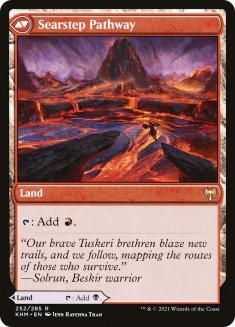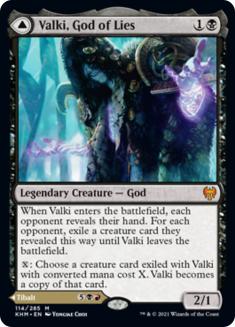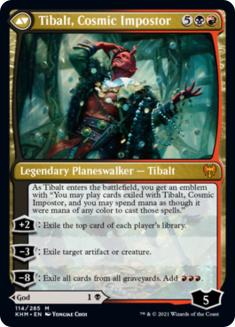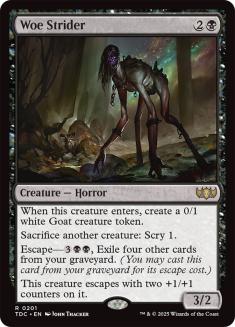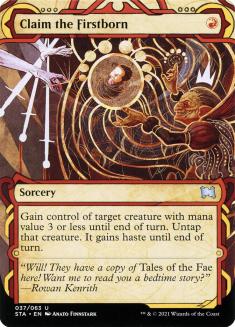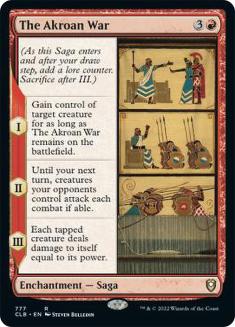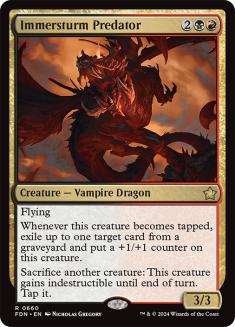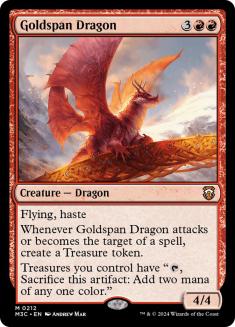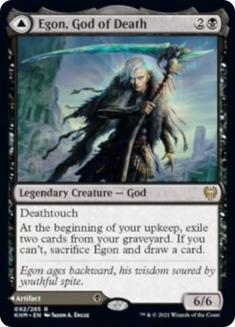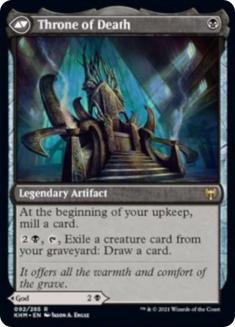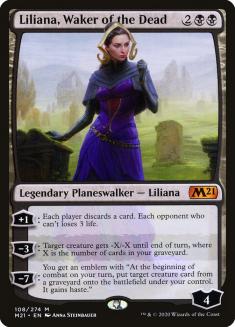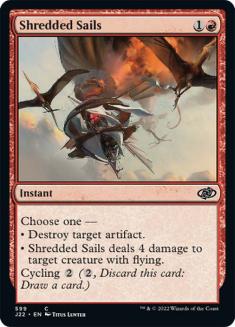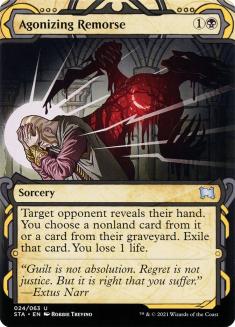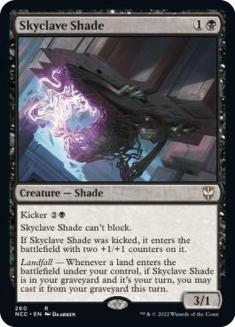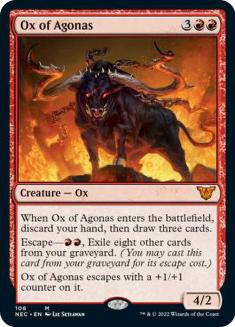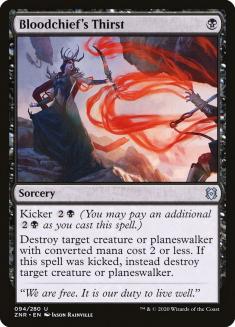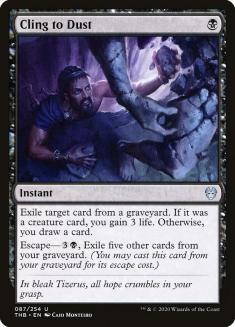A while ago, my team and I played Rakdos Midrange in the first MPL Split to great success. The reason we played it and did well, however, was not because it was an inherently very powerful deck, but because Dimir Rogues was the most-played deck by far. In an open field you could never count on such a high number of Dimir Rogues opponents, so the deck fell out of favor with the general public; it always remained present in the metagame, but it was never a big contender. The standard version of the deck eventually morphed into a Sacrifice build, with Claim the Firstborn and Woe Strider, but that deck also never managed to break through into Tier 1.
With the release of Kaldheim, I think this can change, as the set brings several new cards that are not only powerful cards in the Rakdos colors but that are also particularly good at addressing the problems the deck had. With the addition of these cards, I believe Rakdos Midrange can finally stop being an underpowered metagame choice and become a powerful presence in Standard on its own merits.
Before Kaldheim, I thought Rakdos had three main issues:
- The manabase wasn’t good. Even though Rakdos had access to a lot of very good modal DFCs, which meant it could play a lot of lands without flooding out, you still regularly had mana problems, especially because the deck had very intensive color requirements. Kroxa, Titan of Death’s Hunger had four specific pips in its cost, and it was not uncommon to have to escape an Ox of Agonas and still cast another red spell in the same turn, for example.
- The deck’s early-game was quite clunky. Whether you were playing the Sacrifice version or not, your power cards were always cluttered in the three- and four-mana slots. To give you an idea, we were so desperate for early action in our original list that we played Robber of the Rich (which has since been removed on the account of being bad).
- The sideboard matchup versus Gruul Adventures was quite hard. Game 1 was okay, since you had a lot of removal, but your deck really wasn’t well-equipped to dealing with their transformative sideboard. The moment they showed up with multiple copies of Vivien, Monsters’ Advocate and their own Ox of Agonas, you were fighting an uphill battle. Some people even tried their own transformative sideboards with Ugin, the Spirit Dragon, but they never felt good enough to me.
All together, these problems felt strong enough that I abandoned the Rakdos deck. Luckily for us, the Rakdos cards in Kaldheim solve, or at least help to solve, all three of them.
The first problem is helped tremendously by the addition of Blightstep Pathway, as you now have an extra multicolor land to work with. It doesn’t fix all of the issues by any means, but it’s a big step in the right direction.
The second problem is helped by the addition of Valki, God of Lies, which is everything Robber of the Rich ever hoped to be — a two-drop that you will happily play multiple copies of. Throne of Death is also a card you can cast earlier in the game, though of course it doesn’t have a whole lot of battlefield impact early on.
The third problem is again helped by Valki, God of Lies, but by the back side of it — Tibalt, Cosmic Impostor. Now the Rakdos deck has several copies of its own late-game planeswalker to compete. Again, it doesn’t solve everything, but it’s a step in the right direction.
Furthermore, depending on the version that you’re playing, you can get some extra powerful creatures to threaten Vivien or to just perform better in combat without having to rely on Kroxa alone. It is possible, of course, that Gruul Adventures is supplanted by more Boros-based decks in the future (either straight Boros or Naya) but the philosophy should not be so different; you still need to be able to go over the top of their Showdown of the Skalds + Shepherd of the Flock Engine.
So, how should you play Rakdos Midrange in this format?
My first attempt at playing the deck started with the Sacrifice version — the one playing Woe Strider, Claim the Firstborn and The Akroan War. Naturally, I wanted to try all the new cards in it, so I threw them all together and I found that my deck didn’t really work as well as I’d hoped for a variety of reasons.
The main reason the deck didn’t work was that it was still too clunky. I was only playing two Valkis at that point as extra two-drops and the great majority of my deck cost three and four. There was also the fact that, even though Woe Strider and Egon, God of Death (or more specifically Throne of Death) are individually powerful cards that work with the rest of the deck, they mostly did not work together. The anti-synergy of Throne of Death basically “countering” every scry was extremely annoying. You could still sacrifice a creature on your upkeep if you were desperately looking for something, but you couldn’t block and sacrifice or get a scry in response to a removal spell because Throne of Death would just mill the card anyway.
In the end, I decided that I did not want these two cards in my deck at the same time, and I also did not want to play both Tymaret Calls the Dead and Woe Strider in the same deck, for example — even though they also have some synergy because of the escape I felt that my deck was just cluttered with three-drops.
So, I decided to try splitting the decks — one of the versions should focus on the sacrifice synergies and the other mostly on graveyard synergies. Here’s what I ended up with:
Creatures (21)
- 4 Bonecrusher Giant
- 4 Woe Strider
- 2 Ox of Agonas
- 2 Kroxa, Titan of Death's Hunger
- 4 Valki, God of Lies
- 2 Goldspan Dragon
- 3 Immersturm Predator
Lands (22)
Spells (17)

This deck doesn’t worry about the graveyard synergies at all; it’s not running cards like Mire Triton or Egon, God of Death. Instead, it really tries to maximize the “steal and sacrifice” aspect. Immersturm Predator is a pretty strong card here and provides another free sacrifice outlet alongside Woe Strider.
Immersturm Predator takes a while to get used to, as it doesn’t match some of your preconceived notions for a card like this. For example, even though it’s an at-will sacrifice outlet, you only gain the benefit of the card once per turn cycle. It also triggers any time it’s tapped, which includes the attack phase.
Since you now have two creatures that let you sacrifice your creatures at will, I think you don’t need to play Village Rites. Village Rites is good with Claim the Firstborn and The Akroan War, but it’s not that great with the rest of your deck — you don’t have a card like Stitcher’s Supplier that really wants to be sacrificed — so I prefer relying on permanents to do this. As an additional sacrifice tool I like Kazuul’s Fury more, as that can be played as a land and actually has an impact on the game, especially when you have Kroxa and Immersturm Predator in your deck.
Goldspan Dragon is here more on its individual strength than anything else. This is not a “Goldspan Dragon” deck the same way that the Izzet Midrange❄ decks are, but the deck can still use the mana reasonably well. Tibalt, Cosmic Impostor and Shatterskull Smashing are two of the best “noncommittal” mana sinks in the format, meaning you’re playing a powerful mana sink without playing an expensive card (yes I just made this terminology up — deal with it) and the deck is playing four of both, and a card like Ox of Agonas is also quite good at being a mana sink.
This deck does not have many graveyard synergies, so it only plays two copies of Kroxa as a value card. This is pretty standard for this version of the deck and makes it play more like an aggressive deck than a “trying to get rid of all your cards” deck.
I would say that, as a general rule, the Sacrifice version has supplanted the graveyard version; if I play versus a Rakdos deck on ladder, I would expect it to have Claim the Firstborn and The Akroan War. That said, upon testing it myself, I did not like it as much. There are a lot of decks now that don’t rely on playing creatures (such as all the Yorion decks, which have become quite popular), and a lot of your strength comes from the creature-stealing cards. Furthermore, I’ve run into an unreasonable number of Vorinclex, Monstrous Raiders lately and that card just straight-up counters The Akroan War since the Sagas don’t get counters if it’s on the battlefield.
On top of that, I felt like the non-sacrifice version of the deck just made better use of the new cards. The mana was a bigger issue for that deck (since it relied more on Kroxa) and, more importantly, Valki, God of Lies is an even better card in that version — you’re attacking their hand even more and you had more problems in the late-game than the sacrifice version.
Basically, the way I see it, the Sacrifice version of the deck adopted a slightly more aggressive approach specifically because its late-game wasn’t that good, and now that the late-game is better because of Tibalt, Cosmic Impostor you no longer need to do that. Obviously something like this is always going to be metagame-dependent — some metagames will be insane for Claim the Firstborn and The Akroan War — but the version I’ve liked the most right now is the more graveyard-centric one.
Here’s my current list:
Creatures (23)
- 4 Bonecrusher Giant
- 2 Ox of Agonas
- 4 Mire Triton
- 4 Kroxa, Titan of Death's Hunger
- 4 Valki, God of Lies
- 1 Goldspan Dragon
- 4 Egon, God of Death
Planeswalkers (2)
Lands (21)
Spells (14)

This deck is much more similar to the original Rakdos Midrange list that we played in the very first MPL split. It’s not at all an aggressive deck, though it is capable of some aggressive draws — the plan is mostly to just exhaust the opponent of resources. Basically, this is a Kroxa deck through and through.
Egon, God of Death is a pretty good card. Both sides of it are strong in this deck, but you’re mostly looking to play Throne of Death, ideally as early as possible. Throne of Death both helps you find your graveyard cards (Kroxa and Ox) and also fuels them (on top of fueling Liliana, Waker of the Dead). If you have Throne of Death on Turn 1 and Kroxa, Titan of Death’s Hunger on Turn 2, all you need to escape it on Turn 4 is another graveyard card (such as a Mire Triton) or a spell plus a Fabled Passage.
The card-drawing ability is also very relevant, and means you don’t need to play Castle Locthwain anymore, which was a bit awkward with the mana (and sometimes led to playing Triomes over Temples, for example). It’s worth noting that now you have a real use for a creature card in the graveyard, so exiling enchantments with Tymaret Calls the Dead should take priority.
The God of Death himself is not too shabby. 6/6 deathtouch is huge, and the deck often has no problem keeping it on the battlefield for multiple turns, though it can become a liability at points. Sometimes, you just cast Egon as a deterrent, even if you aren’t planning on keeping it — it effectively Fogs one or two attacks and then it dies and you draw a card. (Did you know you drew a card if you couldn’t keep it? Took me a while to figure that out when the set was first released.)
Given that you want to cast Throne of Death often on Turns 1 or 2 and that you don’t mind drawing multiple copies of Egon because you can get both sides on the battlefield at once, I think it makes sense to play four copies, but I can see cutting down to three if I end up stuck with the God in my hand too often. We do live in a Giant Killer world, so a 6/6 for three is not as reliable as it used to be, but the deck is not lacking for Giant Killer targets regardless, so there’s no real way to avoid it.
Liliana, Waker of the Dead is quite good in this deck — it’s very easy to turn it on as a removal spell and I could see just playing three copies. It does, however, also have Vorinclex problems, much like The Akroan War. Goldspan Dragon is also okay here, as you have the same number of mana sinks as the previous version, but I haven’t found a reasonable cut for the second copy of the card yet. I think Mire Triton is the worst card currently in the deck, but a lot of the games I lose are due to having clunky hands, so I’m wary of cutting a two-mana card for a four- or five-mana card.
The sideboard doesn’t have any superstars, but it’s trying to maximize your strengths in most matchups while dealing with some of your liabilities — in this case, artifacts. The format is still wide-open, so it’s hard to have a specific sideboard guide, but here are the general uses of each card I currently have in it:
The Great Henge is sort of unbeatable for this deck and Shredded Sails is the best answer. I like it more than Embereth Shieldbreaker in this deck because I don’t care that much for the random 2/1 body, and I think instant-speed is good versus both The Great Henge and Embercleave. Furthermore, many of the decks you want Shredded Sails against will play Goldspan Dragon now and it doubles as an answer to that.
These complement your “attack their whole hand” plan. Duress does not get rid of every important card (for example, it notably misses Yorion, Sky Nomad from Yorion decks), but since you’re trying to get rid of all their cards anyway, it often gets the job done. A lot of your deck costs two, three, or four mana, so having a one-mana card that you can sneak in can be quite valuable, especially since it often allows you to cast Kroxa, Titan of Death’s Hunger a turn before you’d be able to.
These are excellent against Dimir Rogues (and part of the reason this matchup is very good for you), but they are also good against many control decks. Now that we’ve added Throne of Death, finding these cards has become even more reliable; if you’re very lucky, you can even cast a Throne of Death on Turn 1 and mill a Skyclave Shade for Turn 2!
Just more removal for aggressive decks. Originally I had Soul Shatter, as it’s the best way of dealing with Goldspan Dragon, but the goal is to discard the payoffs from their hand anyway, so I think you can afford to give them a Treasure most of the time. Bloodchief’s Thirst is, in general, worse than Heartless Act but it’s the best removal for dealing with Scavenging Ooze, which is otherwise a big problem.
Not a super-high-impact card, but a concession to the mirror. You’ll also bring it in versus Dimir Rogues. It’s possible that Elspeth’s Nightmare is a better card in the same role.
Overall, I don’t know for sure that this is the best Rakdos version — it’s still way too early for that and we don’t have a defined metagame — but it’s the one I’d play if I had a tournament right now, as it checks most of the boxes I’m looking for and uses some of the most powerful new cards. If you want to try something slightly different (or if you’re tired of losing to Dimir Rogues), I urge you to try Rakdos Midrange out.



